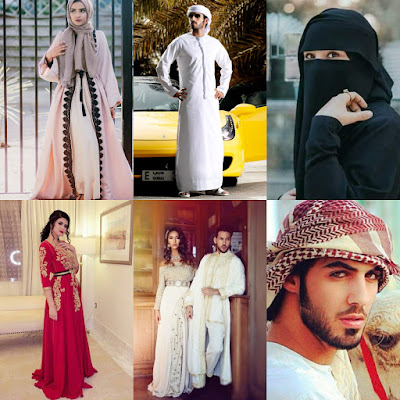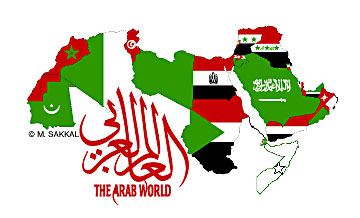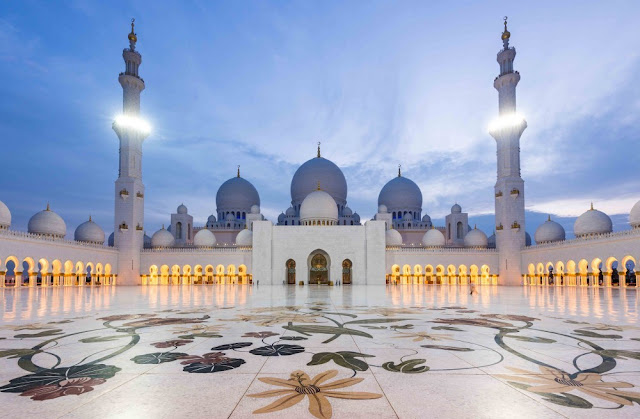Religion
Arabs
mostly Muslims with a Sunni majority and a Shia minority, one exception
being the Ibadis, who predominate in Oman. Arab Christians generally
follow Eastern Churches such as the Greek Orthodox and Greek Catholic
churches, though a minority of Protestant Church followers also exists.
There are also Arab communities consisting of Druze and Baha'is.
 |
| The holiest place in Islam, the Kaaba in Al-Haram Mosque, is located in Mecca, the Hejazi region of Saudi Arabia |
 |
| The Sheikh Zayed Grand Mosque in Abu Dhabi |
Before the coming of Islam, most Arabs followed a pagan religion with a number ofdeities,including Hubal, Wadd, Allāt, Manat, and Uzza. A few individuals, the hanifs, had apparently rejected polytheism in favor of monotheism unaffiliated
with any particular religion. Some tribes had converted to Christianity
or Judaism. The most prominent Arab Christian kingdoms were the Ghathe elites of the other prominent Arab kingdom, the Kindites,
being Himyirite vassals, apparently also converted (at least partly).
With the expansion of Islam, polytheistic Arabs were rapidly Islamized, and polytheistic traditions gradually disappeared.
 |
| Mosque Hassan II, in Morocco |
 |
| Map of Sunni and Shia Muslims |
Today,
Sunni Islam dominates in most areas, overwhelmingly so in North Africa
and the Horn of Africa. Shia Islam is dominant among the Arab population
in Bahrain and southern Iraq while northern Iraq is mostly Sunni. Substantial Shia populations exist in Lebanon, Yemen, Kuwait, Saudi Arabia,northern Syria and Al-Batinah Region in Oman. There are small numbers of Ibadi and non-denominational Muslims too.The Druze community is concentrated in Lebanon, Syria, Israel and Jordan. Many Druze claim
independence from other major religions in the area and consider their
religion more of a philosophy. Their books of worship are called Kitab Al Hikma (Epistles of Wisdom). They believe in reincarnation and pray to five messengers from God. In Israel, the Druze have a status apartefrom the general Arab population, treated as a separate ethno-religious community.
 |
| A Greek Orthodox Church during a snow storm in Amman, Jordan |
Christianity had a prominent presence In pre-Islamic Arabia among several Arab communities, including the Bahrani people of Eastern Arabia, the Christian community of Najran, in parts of Yemen, and among certain northern Arabian tribes such as the Ghassanids, Lakhmids, Taghlib, Banu Amela, Banu Judham, Tanukhids and Tayy. In the early Christian centuries, Arabia was sometimes known as Arabia heretica, due to its being "well known as a breeding-ground for heterodox interpretations of Christianity.Christians make up 5.5% of the population of Western Asia and North Africa. A
sizeable share of those are Arab Christians proper, and affiliated
Arabic-speaking populations of Copts and Maronites. In Lebanon,
Christians number about 40.5% of the population.In Syria, Christians make up 10% of the population.In West Bank and in Gaza Strip, Christians make up 8% and 0.7% of the populations, respectively. In Egypt, Coptic Christians number about 10% of the population. In Iraq, Christians constitute 0.1% of the population. In Israel, Arab Christians constitute 2.1% (roughly 9% of the Arab population). Arab Christians make up 8% of the population of Jordan. Most North and South American Arabs are Christian,so are about half of the Arabs in Australia who come particularly from Lebanon, Syria and Palestine. One well known member of this religious and ethnic community is Saint Abo, martyr and the patron saint of Tbilisi, Georgia. Arab Christians also live in holy Christian cities such as Nazareth, Bethlehem and the Christian Quarter of the Old City of Jerusalem and many other villages with holy Christian sites.
https://www.whyislam.org/brochures-online/islam-explained/
- Obtener enlace
- X
- Correo electrónico
- Otras aplicaciones




Comentarios
Publicar un comentario